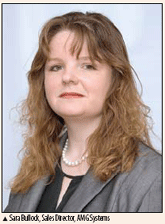The electronic security industry will continue to see growth during the next few years. A&S talks to vendors and researchers across the globe to discuss industry developments in 2008.
The electronic security industry will continue to see growth during the next few years. A&S talks to vendors and researchers across the globe to discuss industry developments in 2008.
In 2008, demand for integrated systems will continue to rise, driven by user requirements for single operating software and greater functionality such as video analytics, automatic license plate recognition and building automation,〃 said Colin Kramer, Marketing Director, ADI-Gardiner EMEA. ¨Product developments will see increased use of wireless technology as a key communication medium for access control. Additionally, there will be advancements and developments in edge technology in video security. The availability of power-over- Ethernet devices will increase, allowing efficiency in installations.〃
The upcoming trends that Archana Rao, Senior Research Analyst, Automation & Electronics, Frost & Sullivan, sees are continued applications in retail, transportation and stadiums as well as non-security surveillance applications in retail (to analyze crowd movement) and transportation (congestion detection). Good growth in the biometric segment is also foreseen.
Situational awareness, a holistic approach using information from all subsystems, is set for wider adoption. Command and control platforms, linking all subsystems into one interface, give a complete overview; as business complexes grow, managing security and non-security systems on a single interface will become a solution increasingly in demand.
Mergers and acquisitions will continue, reflecting greater needs of converged technologies rather than traditional security technologies, said John Fenske, Senior Marketing Manager, Systems, Johnson Controls. Product manufacturers will look to strengthen capabilities in core IP technologies as well as open system architecture. Likewise, system integrators will continue expanding into network infrastructure design and implementation.
¨Expectations regarding prevention and response will be raised significantly in the years ahead,〃 said Fenske. ¨The public has increased awareness of available technologies and, with that, comes an expectation that quick, comprehensive answers will be supplied regarding events and breaches.〃
Because of this, companies need to shorten product development periods to increase product turnover. ¨In the security industry, everyone needs to keep up to speed,〃 said Koji Masunari, Deputy General Manager, Industrial Optics Business Unit, Tamron.
Technology & Products
Alarms
Projected advancements in security technology, said Mark Brandstein, Chief Operations Officer for AES-IntelliNet, include looking into broader bandwidth capabilities of mesh technology, integration of mesh with IP networks when practical, and additional applications of the technology to other telemetry and event-monitoring needs.
Other developments include demise of legacy wire-line telephone services with the transition to cellular and Internet telephony networks. This will further enhance value and attractiveness of mesh radio and private radio for alarm communications since cellular and Internet telephony do not always work well with alarm communications and there are often monthly costs. Finally, remote fire alarm central monitoring will increasingly become a requirement in rapidly developing countries such as India, China and parts of Latin America.
Access Control
The software-as-a-service model is proliferating across many industries, said Meredith Esham, Director of Marketing, Brivo Systems. Companies are deciding that outsourcing software as a service makes more sense than purchasing an expensive license. Businesses benefit with a lower total cost of ownership and an easy-to-deploy and easy-to-use application; SaaS offerings allow them to focus on their core business rather than dedicating resources to running ancillary systems.
Through convergence of physical security and IT, many organizations are finding innovative ways to go beyond protecting assets to share resources and advanced technology. Electronic physical security devices gather and share information to provide benefits, while using communication protocols and infrastructure that are already in place. While typically used to prevent disruption of core business practices, these devices are now being used as strategic business tools. By leveraging integration, they augment business practices and generate revenue.
The next step in evolution of access control systems is putting IP-based network devices at the door. These new single-door network adapters can be configured as stand alone devices with embedded databases and Web servers for administration across local networks.
Biometrics
Biometrics is emerging as the fastest-growing segment of the North American access control market. It is benefiting tremendously from legislation such as the Aviation and Transport Security Act, according to Frost & Sullivan. The International Committee for Information Technology Standards (INCITS) and American National Standards Institute have approved the BioAPI standard, while INCITS 358-2002 Information Technology-BioAPI Specification and the Common Biometric Exchange File Format have been augmented for international harmonization.
Surveillance

With video content analysis software, retaining as much picture content as possible is important, said Sara Bullock, Sales Director, AMG Systems. ¨After compressing the video signal, important information in the picture may have been discarded, never to be retrieved again.〃
The market is moving to next-wave, network video surveillance with IP cameras, IP video servers and NVRs. John Monti, Vice President of Sales and Marketing for Pixim, believes that this wave will transform the surveillance industry. ¨Already, competitors from the networking and technology industry are entering the market. Network surveillance will shift to centralized storage and distributed intelligence, resulting in strong growth of IP cameras, network DVRs and IP video servers, as well as semiconductors and software that underlie these devices.〃

Video surveillance is finding new applications in transportation and retail. The importance of wide-dynamic range surveillance for perimeter security applications is increasing.
¨Between 2010 and 2015, the volume of video traffic will overtake voice and other data running over the Internet,〃 said Eric Fullerton, Corporate Chief Sales and Marketing Officer, Milestone Systems. ¨IP technology is the driver.〃 Furthermore, new innovations are making video surveillance storage options even better and more reliable. Solid-state drives built entirely from flash memory have no moving parts and offer dramatically improved performance. These drives have read and write speeds that approach 100 megabits per second. Mean time between failure (MTBF) is almost 2 million hours, nearly 228 years.
As IP cameras are increasingly commoditized, Fullerton continued, manufacturers of IP-based cameras are attempting to add value by placing analytics in cameras. ¨The truth is that analytics are needed both in the camera (edge) and at the head end (server) because they add value in different ways.〃

Martin Gren, founder and Director of the Board, Axis Communications, agreed. ¨Retail applications illustrate one reason why it makes no sense to have intelligence at only the edge. In order to follow someone around a store, by definition, analytics have to be server-based. A meta-language, such as the MPEG-7, will place processing at the edge. However, at least in retail, the majority of processing will take place at the server.〃
Megapixel will continue to develop strongly, said Dvir Doron, Vice President of Marketing for ioimage. ¨Security officers strive for better detection and more resolution to allow for identification of perpetrators. Note that higher resolution does not mean going fully IP and expanding network usage, but rather utilizing existing viewing screens with new cameras that allow better zoom-in on targets.〃
Camera-to-camera handover and detection automation are other trends. ¨Most video surveillance software today cannot replicate human reasoning or association capabilities,〃 Doron continued. ¨ioimage is striving to simplify the control room operatorˇs tasks by automatically associating events occurring in one field of view with another. If intruders are detected by fixed cameras, PTZ cameras can automatically lock onto them so that they remain in focus even if they leave the fixed camera's scope.〃
According to Adam Rosenberg, Vice President of Marketing, Magal Security Systems, ¨Emphasis will continue to be mostly on development of gadgets for local solutions. Video analysis and biometric analysis are two items. However, although video analysis is very attractive, no one has found a solution to view something that the camera, itself, cannot see. Companies are looking to hit the jackpot with a gadget, but are missing the essence of security keeping intruders out. The emphasis should remain on the overall solution and combination of technologies.〃
Vertical Markets
Doron foresees more specialized video analytic applications. ¨Graffiti has become a plague extending beyond bridges and dark alleys to the front of train cars and public monuments.〃 Other emerging and active verticals include preventing theft of car parts or parcels.
Network camera advances will start verticalization of markets to satisfy unique requirements, agreed John Recesso, Director of Business Development, Security Market, Lumenera. Fine-tuned software algorithms to detect specific cases of retail theft will be critical in solving sophisticated crimes.
¨There are federal standards for municipal government buildings; these are not going anywhere,〃 said Dagan Sadeh, CEO of Visual Defence. ¨Thus, we will be seeing more city-wide security system implementations. Governments are additionally increasing funding of public transportation, leaving more to budget for security system investments. At the same time, mobile security solutions for surveillance and monitoring of buses and trains are becoming more robust and advanced and with greater availability of government funds we see adoption and implementation of these mobile security technologies happening at a more rapid rate.〃
There is incredible pressure on airports the world over to beef up security. More and more airports outside the developed world are taking measures to implement state-of-the-art security technology so that people feel safe traveling to their countries.〃
Regional Markets
Russia continues to be the biggest market in Eastern Europe, said Anders Laurin, Executive Vice President, Axis Communications. Worldwide, although a few fast-growing markets can be identified, all regions can be considered growth markets. Rosenberg agreed: ¨Due to the increase in threats worldwide, there is no specific growth market." All markets have become relevant. Doron named Hong Kong, Taiwan, Spain, the U.S., China and India as prominent markets.
U.S.
The North American electronic access control market looks set for continued growth in the future, said Frost & Sullivan. Revenues in this market are estimated to reach US$4.19 billion in 2010. The possibility of multitechnology authentication is driving market g rowth, and wi th inc r e a s ed competition and reduced prices, this market will witness greater venture capital and equity interest. Moreover, with security concerns becoming top priority, the market is optimistic about a buoyant growth period and richer returns from technology.
Card, audio and video-based access control will also experience growth. While emergence of contactless smart cards will contribute to growth of the card-based segment, the advent of IP-based surveillance systems will enhance growth of audio and video-based access control systems. However, existing investments in legacy systems could deter adoption. Moreover, shift from magnetic-stripe to smartcards is progressing at a slower than anticipated pace, and this represents a major challenge for the smartcard-based market.
The National Burglar & Fire Alarm Association (NBFAA) and Central Station Alarm Association (CSAA) announced production of the Electronic Security Expo (ESX). This new exhibition will focus on product, technical and management training needs of installing and monitoring companies as well as trends toward integration and IP-enabled security systems in the commercial, industrial, institutional and residential markets.
U.K.
Escalating economic worries, higher prices and tighter spending will combine to make 2008 a much tougher year, according to Plimsoll Publishing. ¨Almost every sector of British business stands at a crossroads for the coming 12 months,〃 said Senior Analyst David Pattison. ¨With uncertainty in the economy, some will want to sit tight and do nothing radical; others will need to cut costs quickly to weather the possible storm.〃 Security firms should be aiming for at least 4 percent growth in 2008, but this could be improved upon with imagination and forward thinking.
An MSI report, however, predicts that the U.K. market will grow by 14.2 percent in value terms to 2011. Current market drivers, including technological innovation and fear of crime, will remain, while organization of the Olympic Games will enable growth in demand for electronic security systems. The report also predicted that integrated systems will begin to increase, with non-integrated system sales decreasing from 2008 onward. ¨Integrated solutions are becoming more and more attractive for consumers in both residential and non-residential sectors,〃 the report said.
APAC

The region is likely to be the fastestgrowing region for card technology, biometric readers and integrated keys in 2008, with estimated growth rates of more than 6 percent, said Jafizwaty Ishahak, Industry Manager, Smart Cards, AutoID and Security, APAC, Frost & Sullivan. Video surveillance in the security segment is estimated to grow more than 28 percent in 2008.
Government buildings and landmarks as well as transportation systems in this region have been prime targets for terrorist activities. Other key drivers include developing physical infrastructure and thriving economies leading to growth in sectors such as banking and financial institutions, retail and hospitality.
Gaming is also among the strong growth areas for video surveillance. Macau has emerged as the Asian Las Vegas with 17 casinos. Growth in the number of gaming tables is expected to be faster than number of casinos added, which implies that the market opportunity for video surveillance is strong. Casinos also exist in Australia, Malaysia, Vietnam and the Philippines. Singapore and other markets in Asia are expected to open casinos in the next three to four years as well.
India

The corporate vertical, especially IT/IT-enabled services companies, said S. Mushtaq Md Khan, Industry Manager, Environment & Building Technologies Practice, Frost & Sullivan, South Asia & Middle East, requires highly secure integrated security solutions which converge with their IT systems and increase ROI by providing multiple functions including protection against theft and arson, safeguard of proprietary information, and human resource management. Suppliers and system integrators in India still face the challenge of supplying cost-effective systems.
China
The Chinese market for analog devices, namely matrices, quads, analog multiplexers and analog recorders is forecast to decline until 2011, said IMS Research. This is mainly due to increasing penetration of digital and network devices, such as DVRs, video servers and network cameras. Average prices for most CCTV and video surveillance types are forecast to fall, mainly because of price competition as well as increasing penetration of low-priced domestic brands.
